Hypoprepia lichen moths: What a mess!
Based on occasional questions and queries about certain species of the lichen moth genus Hypoprepia (Erebidae: Arctiinae), I did some quick research on uploaded images on iNaturalist. I focused on the biggest long-standing problem which is trying to distinguish Painted Lichen Moth (H. fucosa) and Scarlet-winged Lichen Moths (H. miniata). A few things are for sure:
— The separation of these two species is very difficult, particularly in Texas.
— The older literature and newer field guides dreadfully oversimplify this ID challenge.
— The patterns of wing and thorax coloration vary in complex ways geographically.
— Thus far, barcoding analysis has not helped to separate the two species (Palting et al, 2018).
In the literature and field guides, we read that the way to ID each of these species is boiled down to this:
— Scarlet-winged Lichen Moth has the ground color of the forewings all red, wide black terminal band on hindwings, and an all red thorax.
— Painted Lichen Moth has substantial yellow/orange in the basal 2/3 of the forewings, narrower black terminal band on the hindwings, and a dark gray spot in the middle of the thorax.
There are other details mentioned occasionally in the literature (like Scarlet-winged have a black terminal abdominal segment), and the hindwings of course are not visible in the vast majority of field photos. That said, these statements provide a classic example of the danger of oversimplified field marks. Apparently NOT ONE of the suggested field marks is true all the time or everywhere. Not even close. There are major exceptions to each aspect across the range of each species, not just the occasional aberrant individual.
I’m still working on sorting through all the images and trying to pin down any additional visible/measurable characters that might help with this ID. That work is ongoing, but I wanted to address one of the above marks—the gray spot on the thorax—because it illustrates the complexity of the situation. So here’s what I did today:
I examined all H. fucosa and H. miniata images uploaded to iNat as of 8 June 2021 and which have been identified to species level. Because of the great uncertainty in this set of species and because misidentifications are probably abundant, I made the ultra-conservative starting assumption that I would take ALL identifications at face value—not necessarily accepting them, but just taking them as a starting point for this particular analysis. I did not go through and add/change any IDs prior to this compilation; hopefully, additional research might allow me or someone else to do that. It isn’t appropriate or possible at present.
Then, I compiled the number of observations of moths (usually one per observation) that showed a gray spot or line in the center of the thorax. Note: This “field mark” is highly variable; the gray spot varies in width from a wide square/rectangle to just a thin streak of gray down the center of the thorax. IF there was ANY gray, I counted it as a gray spot. Another note: Something not described in any literature or guides is that the gray spot is typically situated in the middle of a yellowish thoracic disk which is paler than the flanking reddish tegulae (sides of the thorax). In many populations, as the gray spot narrows and disappears, many individuals appear to have just a yellowish center to the thorax which contrasts only slightly with the reddish tegulae (see two examples from Missouri, below). I counted these as “no gray spot” although I think this is part of a continuous phenotypic range of variation. Yet there are many, many Hypoprepia’s (apparently of both species) with true, immaculate, uniformly-colored reddish/orangish thoraces. So I pigeon-holed all this variation into simply “gray spot or not”.
In a few instances where there are very large numbers of observations (fucosa in Ontario, Vermont, and Texas; miniata in Ontario), I only examined the first 200 usable adult images. I obviously ignored images of larvae, images showing only the underside of a moth, and moths on which there was so much wear on the thorax that the presence/absence of a gray spot couldn’t be judged. I also ignored, for the time being, about 261 observations which have been left at the genus level, even when I might have thought I could safely add an ID. I’ll try to do that later; for the present, I ignored them. There are many inherent biases in collections of iNat images, including multiple images of the same moth by different people, over-representation of certain locations by enthusiastic moth photographers, and of course my own errors in judging or counting gray spots. I gloss over all these for the present discussion. I can offer a pdf of my raw research notes for these state-by-state and province-by-province counts; message me below if you're interested.
For starters, here is an array of photos which show the variation in the thorax coloration in H. fucosa:
All images are used under a CC-BY-NC license.
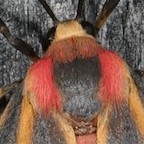
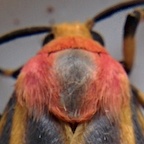




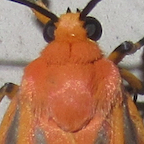
Top row, from L to R: Quebec (@larivee), Ontario (@robertdifruscia), Quebec (@imbeaul), Michigan (@jaspersail), Missouri (@cunningly),
Bottom row, L to R: Missouri (@wildreturn), and Texas (@gcwarbler).
Here's an example of the distinctive Florida population of H. fucosa (@gaudettelaura). Note the presence of a gray spot; this differs from most other populations in the southern U.S.:

Next is a set of Hypoprepia miniata from across its wide range:



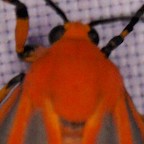

From L to R: Ontario (unusual form with gray spot; @bugsrock), Ontario (@markread), Ontario (@timthorington), Oklahoma (@zdufran), and Florida (@mikehanson11).
The hand-drawn map below shows the percentage of all fucosa images by U.S. state which show a gray spot. (The percentage of Canadian fucosa examples with a gray spot ranges from 99-100% across all provinces from Alberta to Nova Scotia.)
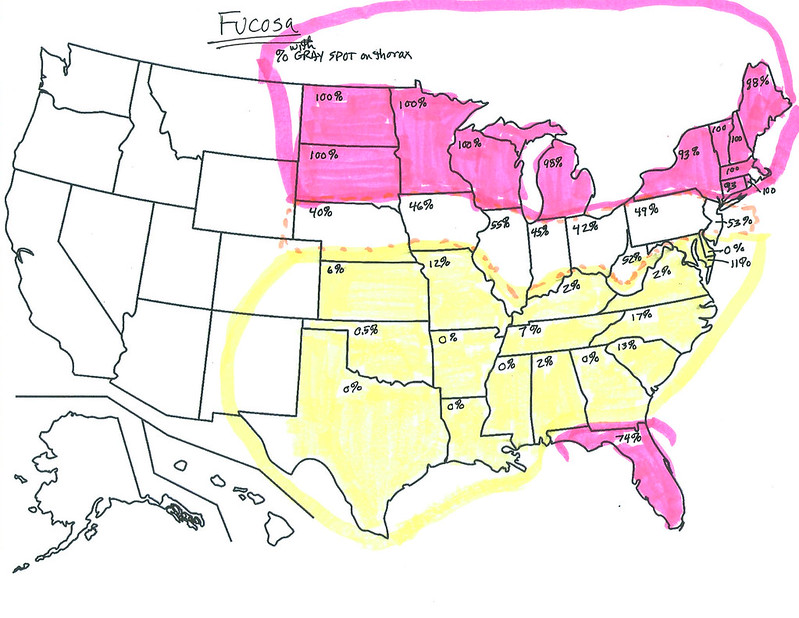
Here are some simple conclusions about the gray spot on the thorax of these two species:
— Painted Lichen Moth (H. fucosa) shows major variation in the presence of the spot. Across all of Canada and the northern tier of states from the Dakotas east to New England, the gray spot is nearly universal on identified images (pink area across the top of U.S.). At least 96.7% of these moths show a gray spot on the thorax; just 22 of 671 observations identified as fucosa in this region lacked a gray spot. This is probably a direct outcome of the traditional statements in the literature and guidance in field guides. Those “exceptions to the rule” are sprinkled from Ontario and Michigan east to New York and Maine.
— Across the southern U.S., from Kansas, Oklahoma, and Texas east to Maryland, Delaware, and down to Georgia, the gray spot is predominantly absent on identified fucosa (yellow shaded area on map). Only 68 of 1014 observations of identified fucosa showed a recognizable gray spot; this constitutes only 6.7% of identified individuals. Most of these “gray-spotted” fucosa in the southern U.S. are in Missouri and the mid-Atlantic Coast, but none of those states exceeded 17% of the sample with gray spots.
— There is a conspicuous zone right through the middle of the country from Nebraska and Iowa eastward to Pennsylvania and New Jersey where the percent of gray-spotted fucosa hovers around 40 to 50%. This is obviously a zone of blending or overlap in this character. It’s one of the regions of the country which deserves some more fine-grained examination in the future.
— A conspicuous outlier is Florida, in which 3/4 (74%) of all identified fucosa moths show an obvious gray spot, bucking the trend across the rest of the South. From a biogeographic standpoint, I don’t know what this means; it’s a distinctive and counter-intuitive result. Whatever the genetic factor or factors are that result in this Florida gray-spotting, they may also be the contributor, via gene migration or introgression up the coastal plain, to the slightly higher proportions of gray spotting in the mid-Atlantic States (well to the south of the northern gray-spotted region).
— Over the entire range of identified miniata, gray spots are notably rare. This is to be expected because of the literature and field guide pronouncements which heavily influence identifications. It simply goes against the grain to identify a Hypoprepia with a gray thorax spot as miniata (notice @bugsrock's example from Ontario, above). Fully 93% of all the identified miniata’s have a red thorax. The biggest occurrence of gray spots on miniata are in a large sample of the species in Ontario, Canada (26% of my subsample of 200 observations). Just 1 to 6 identified miniata with gray spots were scattered among 8 other states and provinces and most of these were in Canada.
The forewing ground color in this large sample of the two species shows even more exceptions to the rules (above) than the gray spots. There are innumerable identified miniata which have orange or yellow ground color or even fucosa-typical yellowish basal 2/3 of the forewings. I suspect a large chunk of these are misidentified. Similarly, among the sample of over 2000 fucosa observations that I examined, there is at least a small portion of them (in all regions) which appear to have the ground color of the wings completely red. Here again, a great many of these may be misidentified miniata, but were placed in the fucosa bucket simply because they have a gray thorax spot and we have been following the standard litany of the literature and field guides.
The correlation and geographic distribution of these various visible marks still need much work and analysis. For the moment, I would apply these “quack like a duck” rules:
— Across Canada and the northern U.S., if a moth has a gray thoracic spot and exhibits some orange or yellow tint on the forewings, label it as fucosa. If it is all scarlet including the thorax, label it miniata. If it shows some confusing or hard-to-judge combination of marks, put it at the genus level.
— Across the southern U.S., moths of this group which show the characteristic 2/3 base of the FW’s with yellowish ground color—irrespective of the presence/absence of a gray thorax spot (which will normally be absent), should be labeled fucosa. Only moths with all scarlet ground color on the forewings and thorax will deserve to be labeled miniata. Moths with intermediate orangy coloration for all the forewing ground color should probably be left at genus level.
What are we left with at present? Below are some cherry-picked images showing some "typical" examples of each species from far-flung corners of their respective ranges. There is much more variation in each region than can be illustrated here in just a small handful of images.


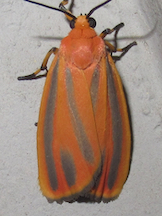
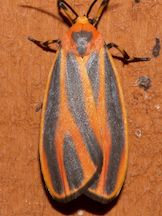
Painted Lichen Moths (H. fucosa), L to R: Ontairo (@robertdifruscia), Virginia (@davewendelken), Texas (@gcwarbler), Florida (@gaudettelaura).
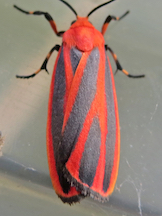

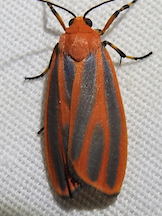

Scarlet-winged Lichen Moth (H. miniata), L to R: Ontario (@markread), Virginia (@vailbass), Texas (@sambiology), and Florida (@gaudettelaura).
One thing that jumps out at me from uploading the previous arrays of images is that the two species seem to be much more difficult to separate in Texas than anywhere else--IF all of these are correctly IDed. Not surprisingly, Texas has the highest percentage of images currently left at the genus level. I don't know what that means. For many years I have been skeptical if true Scarlet-winged even occurs at all in Texas; we really don't see many/any typical "scarlet" examples. I guess I should complain that Hypoprepia-watchers in the northern latitudes and in Florida have it easy, but that's not really the case. As I mention above, the regional variation is considerable everywhere.
Future research should aim at sorting out the relationships of the thorax and wing patterns geographically, especially in the blend zone. Someone needs to dig back into original literature (e.g. early 20th century) to see what genitalic differences there may be. And of course, more DNA analysis (not just COI barcodes) is definitely needed on a continental scale to sort these out.
Oh, did I mention Hypoprepia cadaverosa (the “Cadaver Lichen Moth”) of the central and southern Rocky Mountains? It’s a dark western cousin of the above two species…or is it more like a sibling or twin?
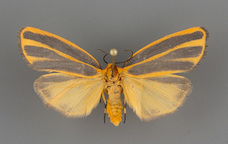
H. cadaverosa from New Mexico (@ronaldparry).
Time will tell.









